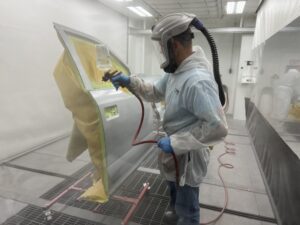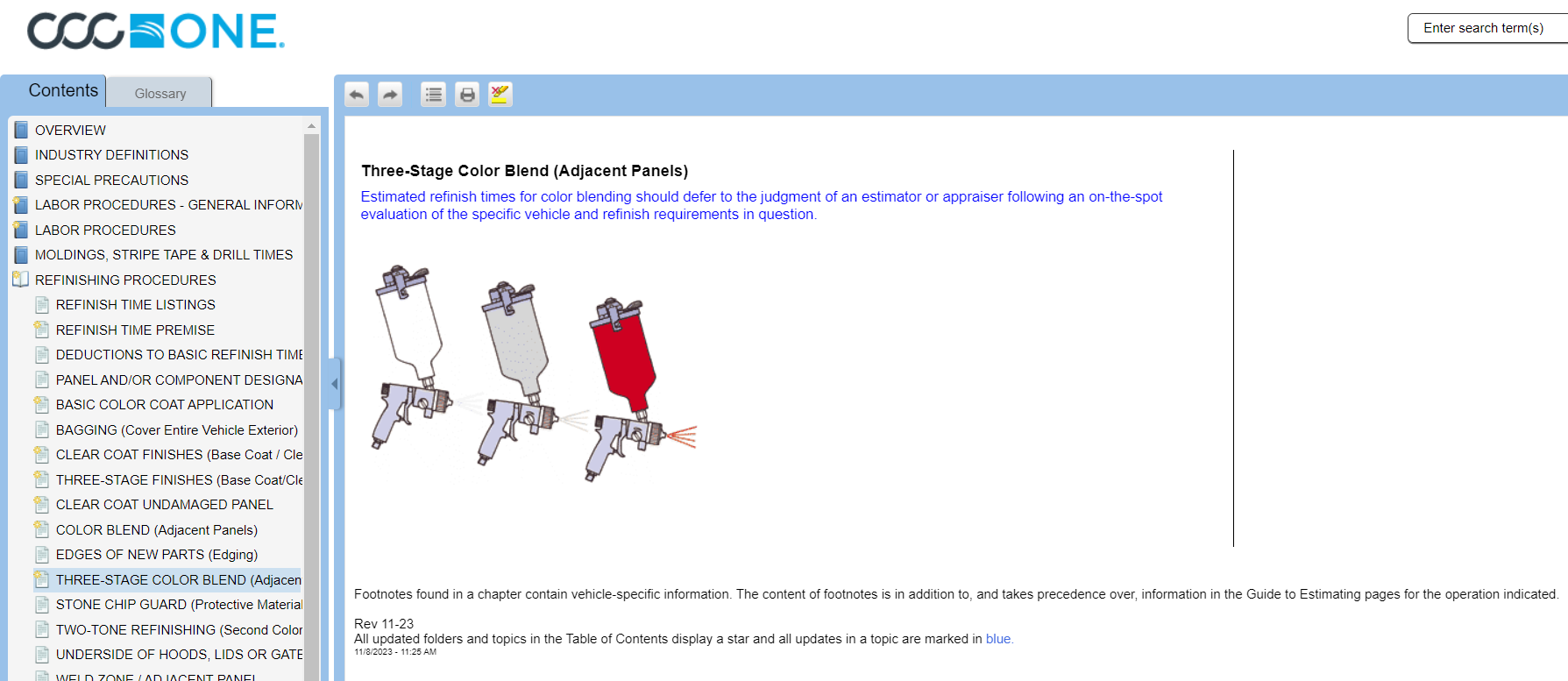
Blend study: CCC continues rollout of labor default override, no update from Mitchell & Solera
By onCollision Repair
CCC Intelligent Solutions has begun rolling out its latest desktop client update to CCC One, which provides solutions in line with MOTOR’s revision for color blend of adjacent panels as a judgment in lieu of the previous fixed calculation for panel blend.
“Release 40 of the desktop client is rolling out now,” said CCC Product Management Vice President Mark Fincher. “We expect all of our repair facility customers to be on release 40 by the end of the year. Estimates written on cccone.com will use the new blend settings now (no update to the client is required when using cccone.com).”
The blend percentages in MOTOR Information Systems (MOTOR)’ Guide to Estimating (GTE) have also been updated, changing the Estimated Worktime Development Methodology for color blend of adjacent panels.
Color Blend (Adjacent Panels): Estimated refinish times for color blending should defer to the judgment of an estimator or appraiser following an on-the-spot evaluation of the specific vehicle and refinish requirements in question.
Three-Stage Color Blend (Adjacent Panels): Estimated refinish times for color blending should defer to the judgment of an estimator or appraiser following an on-the-spot evaluation of the specific vehicle and refinish requirements in question.
“Per MOTOR’s revision, the refinish time associated with color blend of adjacent panels will defer to the judgment of an estimator or appraiser. This change impacts both two-stage and three-stage blend procedures,” CCC’s Zendesk Knowledge Base states.
It adds that, without the update, all CCC Estimating apps calculate each blended adjacent panel at 50% of the panel’s published refinish time for two-stage processes and 70% for three-stage processes. For example, [default %] x [published refinish hours] = blend hours.
MOTOR’s revision does the following:
-
- Allows default percentages for both two-stage and three-stage blends to be configurable by the repair facility;
- Prompts labor preferences for blend operations as desired by the repair facility;
- Allows insurance-specific blend rules to be configurable by the repair facility; and
- Underlines all refinish labor times associated with blend operations on estimates.
The comparative study concluded blending took 31.59% more time on average than a full refinish based on results from refinish operations compared on 45 different parts with three colors from the five paint and coatings companies. The results were a stark contrast to the 50% less time historically allocated in the three estimating systems.
Once the update is active, repairers will have the option to input additional profiles based on specific agreements by using a primary profile override.
Fincher told Repairer Driven News a complete job aid to configure defaults that prompt for “blend adjacent panel” is available under the help section of CCC One. It can be found by typing “blend” in the “search help” box located at the top right corner of the desktop version. Or, click the question mark in the top right of cccone.com.
An updated release for insurers with the same configuration options for “blend adjacent panel” is also currently rolling out.
A full walkthrough on how to find and configure the default blend rules for your repair facility is also available here.
During the Collision Industry Conference (CIC)’s fall meeting last week, a repairer audience member asked for an update on estimating system changes made as a result of the blend study.
SCRS Executive Director Aaron Schulenburg responded, “We continue to see movement from Solera on the commitments that they had made that we communicated at the July meeting; seeing some of those items become inserted into the actual operations of their estimating product. Same with CCC — they continue to move with theirs.”
He noted CCC published the update on Zendesk on Oct. 17, which notified repairers and insurers on how the changes would be applied.
Schulenburg didn’t have an update from Mitchell and invited anyone with the company who was in the meeting room to provide one.
When RDN asked for an update on their response to the blend study results, Mitchell International said, “Mitchell has no comment at this time.”
Audatex/Solera also hasn’t shared formal changes to their products yet.
As an interim workaround, Solera Industry Relations Vice President Bill Brower previously told SCRS via email that, “In the meantime, as discussed, our Solera estimating solution is the easiest one for users to adjust for edits like changes to the blend calculation.”
Solera provided an instruction document, published in March as a Database Enhancement Gateway (DEG) estimating tip. The document specifies how a business can use the Solera estimating solution to adjust for a change to the blend calculation.
RDN asked for an update earlier this week but didn’t receive a response by the publication deadline.
Images
Featured image: A portion of the week-long blend study coordinated by the Society of Collision Repair Specialists (SCRS) is shown at the Global Finishing Solutions (GFS) Center for Excellence, at the GFS headquarters in Osseo, Wisconsin, in August 2022. (Credit: SCRS)
Secondary photos: Screenshots taken on cccone.com and slides from a CIC Parts & Materials Committee July presentation on the blend study.






